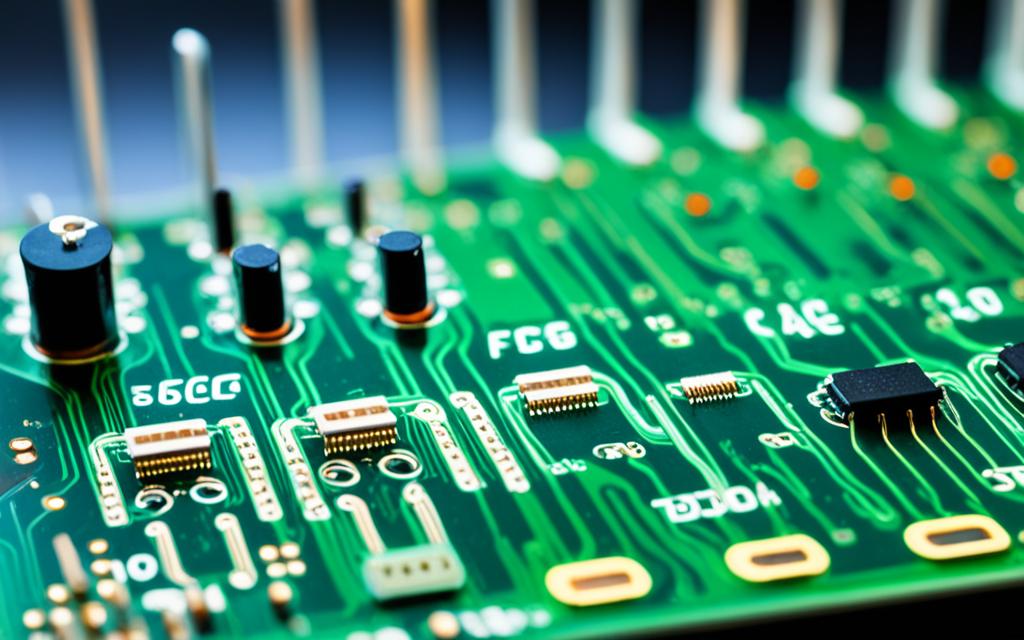Table of Contents
It’s really important to keep an eye on your computer’s CPU temperature. This makes sure your computer works well and lasts longer. CPUs work best when they’re between 40–65°C (104–149°F) during light tasks1. But when you’re doing something that needs more power, like playing games, the temperature can go up to 70–80°C (158–176°F)1.
Staying within these temperature limits is key to avoiding overheating. Overheating can harm your computer and make it less efficient over time. If your cooling system isn’t good enough or there’s not enough air flow, it could make things worse. So, keeping your CPU cool is a big part of making sure it works well for as long as possible.
Learning how to keep an eye on and manage your CPU’s temperature can boost its performance. It also helps your computer last longer. If you want to know how to keep your CPU at the right temperature, check out this great resource.
Key Takeaways
- Optimal CPU temperature ranges between 40-65°C during normal use.
- Under load, CPU temperatures can rise to 70–80°C, necessitating careful monitoring.
- Regularly managing CPU temperature helps prevent damage and maintain efficiency.
- Effective cooling systems are vital for CPU longevity and performance.
- Monitoring tools can provide real-time data to avoid overheating.
Understanding CPU Temperatures
Understanding your computer’s CPU temperature is key to keeping it running smoothly. CPU temperature is the heat your central processing unit generates. It’s a good way to check both performance and health. Learning about the importance of CPU temperature helps you keep your computer in top shape. It prevents breakdowns too.
What is CPU temperature?
The CPU temperature definition is pretty simple. It’s the heat level inside the processor when it’s working. This temperature can change based on the tasks it’s doing. Usually, CPUs work well between 40°C and 80°C for regular tasks. For tougher jobs, they can get as hot as 90°C2. Knowing this helps you avoid overheating your computer.
Why CPU Temperature Matters
The heat of your CPU is something you can’t ignore. When it gets too hot, your computer won’t work as well. And if it’s always overheating, parts of it can stop working for good. When the temperature hits about 85°C, your CPU slows down3. So, making sure your computer stays cool is crucial. This means keeping it clean and maybe even getting better cooling parts.
| CPU Usage Type | Ideal Temperature Range (°C) |
|---|---|
| Idle | 30-40 |
| Light Load | 40-60 |
| Gaming | 60-85 |
| Intensive Tasks | 70-95 |
What Temp Should CPU Be At
Knowing the right temperature for your CPU is key to keeping it running well. It helps your system last longer. Idle and light-use temperatures are important for a healthy computer.
Idle and Light Use Temperatures
When your computer isn’t doing much, the CPU should be between 30°C and 40°C (86°F to 104°F). A temperature below 45°C is best for idle CPU performance. It stops the parts from being stressed4. Intel CPUs should be under 40°C during idle. AMD Ryzen CPUs are okay in this range too4. Keeping these temperatures helps stop overheating and keeps the CPU working longer.
Normal Operating Temperatures Under Load
With tasks like gaming or video editing, CPU temperatures rise. It’s fine for CPUs to get between 75°C (167°F) and 80°C (176°F) when playing games5. They may even hit 95°C (203°F) under a lot of pressure. This shows why keeping your CPU cool matters6.
Staying above 80°C (176°F) can slow down your computer5. Knowing these temps helps you keep your computer running smoothly.
| Performance State | Temperature Range (°C) | Temperature Range (°F) |
|---|---|---|
| Idle | 30°C – 40°C | 86°F – 104°F |
| Light Use | 30°C – 50°C | 86°F – 122°F |
| Gaming | 75°C – 80°C | 167°F – 176°F |
| Heavy Load | Up to 95°C | Up to 203°F |
| Maximum Safe Temperature | Below 100°C | Below 212°F |
By understanding these temperature levels, you can make sure your computer stays in the safe zone. This helps your hardware work better and last longer6.
Signs of Overheating
Knowing when your CPU is too hot is key to keep it running well and for a long time. Spotting the signs early can stop damage and keep your computer fast.
Common Symptoms of Overheating
Look out for several overheating symptoms. These are:
- Slow performance as the CPU can’t handle tasks well.
- It might shut down suddenly to avoid damage.
- You could hear fans making a lot of noise.
- And see signs like burned parts, showing it’s way too hot.
Try to keep your CPU under 80°C (176°F) when working hard and under 60°C (140°F) when not doing much7. Noticing these symptoms early is important to prevent damage8.
Understanding Thermal Throttling
When a CPU gets too hot, it slows down on purpose. This is called thermal throttling. It lowers speed and power use to cut down on heat. But if it happens a lot, your computer might start to lag.
Fixing overheating means looking at airflow, cleaning out dust, or getting better coolers. This helps your CPU stay cool and work better without getting too hot again7.
How to Monitor CPU Temperature
Monitoring CPU temperature is key for your computer’s best performance and longer hardware life. You can choose from several methods to do this effectively.
Using BIOS to Check CPU Temp
The BIOS CPU check is easy to use. Check the CPU temperature in the BIOS setup before your system starts. It’s a reliable way to see if your CPU’s temperature is okay.
Third-Party Software Options
A variety of CPU temp software tools are available for detailed monitoring. Tools like Core Temp and HWMonitor offer real-time data and graphical interfaces. Yet, these programs may slightly use your CPU’s power. Keep an eye on your CPU’s heat with these, especially if it gets above 80°C. High temperatures can slow your computer down and hurt it over time910.
Infrared Thermometers for Accurate Measurement
Infrared thermometers offer a touch-free way to measure CPU temperature. They’re fast and don’t affect your computer’s performance. This method is a great addition to your thermal monitoring routine.
Using both the BIOS check and trusted software helps keep your system’s temperature in check. For tips on keeping ideal temperatures, check out this guide on CPU temperature management9.
Strategies for Maintaining Optimal CPU Temperatures
In today’s tech-driven world, keeping the CPU temperature right is key for good performance and a long life. Using great CPU cooling ways not only cuts the overheating risks but makes computing better too.
Enhancing Cooling Solutions
For better heat management, it’s important to improve cooling systems. You might want to look into cooling options like:
- Air Coolers: They can beat the heat well with high airflow.
- Liquid Cooling: Known for pulling heat away efficiently.
- Thermal Paste: Putting on new thermal paste every three years keeps heat transfer up to speed.
Cleaning components from dust helps keep air moving, which boosts cooling. Check and tune up your cooling system regularly for better heat handling and a healthier CPU.
Importance of Proper Case Ventilation
Good ventilation is crucial for managing CPU temps. Without it, even the top cooling methods can’t stop overheating. Try these tips:
- Tidy up cables to better air flow inside the case.
- Put fans in the right spots to help air move smoothly through the case.
- Make sure your PC isn’t crowded to avoid heat from building up.
By looking after these points, you can set up a space that’s good for keeping things cool and running well. Keep in mind that good ventilation in the case is just as important as having the best cooling systems1112.
Conclusion
Keeping your CPU at the right temperature is vital for its durability and peak performance. It’s important to know what makes your CPU hot and how to cool it down properly. Using strong>temperature management and cooling solutions can really improve how your computer works. It’s also crucial to check the CPU’s heat regularly and fix overheating quickly to keep it working well.
To keep your CPU in top shape, use software designed for monitoring its heat. Being ahead of potential issues is key. For instance, you can watch your CPU’s temperature as it works and use special tools to check its heat levels for better care. If you want to know more about keeping your hardware cool, here’s a great site to explore: monitoring your CPU temperature.
Knowing the safe heat levels for your CPU and using extra cooling gear can make your computer run better. Try to keep your CPU’s heat under 80°C for the best performance, especially when running demanding programs. Such proactive steps help you enjoy a strong, efficient computer while avoiding overheating1314..
FAQ
What is CPU temperature and why is it important?
CPU temperature is how hot the central processing unit gets when it works. This heat level is vital because it affects the computer’s overall performance and shows if the CPU is working right. Keeping the temperature in check is needed to avoid too much heat. Too much heat can lower performance and harm the computer.
What are the optimal CPU temperatures for different usage scenarios?
For simple tasks or when the computer is not doing much, the CPU’s heat should be between 30°C and 40°C. But if you’re playing games or editing videos, it can get hotter, around 60°C to 70°C. It’s important to keep it below 80°C to make sure the CPU stays healthy.
What are the signs of CPU overheating?
Overheated CPUs can make your computer shut down suddenly, crash often, or run very slowly. To stop damage, CPUs will slow down on purpose if they get too hot. This is called thermal throttling.
How can I effectively monitor my CPU temperature?
You can check the CPU temperature in the BIOS before Windows starts, which tells you the temperature early on. You can also use apps like Core Temp for a live reading. Or, use an infrared thermometer for a quick check without interrupting the CPU.
What strategies can I employ to maintain optimal CPU temperatures?
Improving your computer’s cooling is the best approach. Clean out dust regularly, apply new thermal paste, and think about better cooling options, like air or liquid systems. Making sure your computer case is well-ventilated helps too. This means organising cables and setting up fans to move hot air out efficiently.
Why should I regularly check my CPU temperature?
Keeping an eye on CPU heat helps you avoid overheating. By checking it often, you can make sure your CPU works in a safe temperature range. This keeps your CPU running well for longer, whether you’re doing everyday tasks or something more demanding.
Source Links
- https://www.avast.com/c-how-to-check-cpu-temperature – How to Check and Monitor Your CPU Temperature
- https://www.linkedin.com/advice/3/what-normal-optimal-ranges-cpu-temperature-different – What are the normal and optimal ranges of CPU temperature for different types of processors?
- https://computercity.com/hardware/processors/normal-cpu-temperatures – Normal CPU Temperatures: Guidelines for Safe & Optimal Performance – ComputerCity
- https://www.merchmates.co.uk/blog/tech/good-idle-cpu-temp/ – What Is A Good Idle CPU Temp?
- https://www.shiksha.com/online-courses/articles/all-about-cpu-temperature-range/ – CPU Temperature Range That Must Be Maintained – Shiksha Online
- https://www.lolvvv.com/blog/normal-cpu-temp-while-gaming – What is a Normal CPU Temp While Gaming?
- https://www.linkedin.com/advice/0/what-common-causes-symptoms-cpu-overheating-skills-computer-repair – What are the common causes and symptoms of CPU overheating?
- https://www.drivereasy.com/knowledge/how-to-know-your-cpu-overheating-and-fix-prevent-it/ – How to Know Your CPU Overheating and How to Fix It – Driver Easy
- https://www.tomshardware.com/how-to/how-to-check-cpu-temp-temperature – How to Check Your CPU Temperature
- https://www.pcmag.com/how-to/how-to-monitor-your-cpu-temperature – cpu temperature monitor
- https://us.vaio.com/blogs/innovation-hub/how-to-monitor-your-cpu-temperature – How To Monitor Your CPU Temperature
- https://www.pandasecurity.com/en/mediacenter/how-to-check-cpu-temp/ – How to Check Your CPU Temperature – Panda Security
- https://forums.tomshardware.com/threads/are-my-cpu-temperatures-normal.3437233/ – [SOLVED] – are my CPU temperatures normal?
- https://www.pugetsystems.com/labs/articles/impact-of-temperature-on-intel-cpu-performance-606/ – Impact of Temperature on Intel CPU Performance








